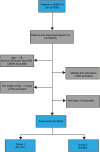Relationship between the magnitude of haemoglobin changes and long-term mortality in patients with sepsis: a retrospective cohort study
- PMID: 38862875
- PMCID: PMC11167884
- DOI: 10.1186/s12879-024-09476-w
Relationship between the magnitude of haemoglobin changes and long-term mortality in patients with sepsis: a retrospective cohort study
Abstract
Background: Sepsis is a common and severe disease with a high mortality rate in intensive care unit (ICU). The hemoglobin (HGB) level is a key parameter for oxygen supply in sepsis. Although HGB is associated with the progression of inflammation in sepsis patients, its role as a marker following sepsis treatment remains unclear. Here, we studied the correlation between early temporal changes in HGB levels and long-term mortality rates in septic patients.
Method: In this retrospective study of data on patients with sepsis from the Medical Information Mart for Intensive Care (MIMIC) IV database, the outcome was long-term mortality. Patients were divided based on the cut-off of the HGB percentage for receiver operating characteristic (ROC) curve calculation. Kaplan-Meier (KM) survival curves and Cox proportional hazards regression models were used to analyse the associations between groups and outcomes. Propensity score matching (PSM) was used to verify the results.
Results: In this study, 2042 patients with sepsis and changes in HGB levels at day 4 after admission compared to day 1 were enrolled and divided into two groups: group 1 (n = 1147) for those with reduction of HGB < 7% and group 2 (n = 895) for those with dropping ≥ 7%. The long-term survival chances of sepsis with less than a 7% reduction in the proportion of HGB at day four were significantly higher than those of patients in the group with a reduction of 7% or more. After adjusting for covariates in the Cox model, the hazard ratios (HRs) with 95% confidence intervals (CIs) for long-term all-cause mortality in the group with a reduction of 7% or more were as follows: 180 days [HR = 1.41, 95% CI (1.22 to 1.63), P < 0.001]; 360 days [HR = 1.37, 95% CI (1.21 to 1.56), P < 0.001]; 540 days [HR = 1.35, 95% CI (1.20 to 1.53), P < 0.001]; 720 days [HR = 1.45, 95% CI (1.29 to 1.64), P < 0.001]. Additionally, the long-term survival rates, using Kaplan-Meier analysis, for the group with a reduction of 7% or more were lower compared to the group with less than 7% reduction at 180 days (54.3% vs. 65.3%, P < 0.001), 360 days (42.3% vs. 50.9%, P < 0.001), 540 days (40.2% vs. 48.6%, P < 0.001), and 720 days (35.5% vs. 46.1%, P < 0.001). The same trend was obtained after using PSM.
Conclusion: A ≥ 7% decrease in HGB levels on Day 4 after admission was associated with worse long-term prognosis in sepsis patients admitted to the ICU.
Keywords: HGB; Long-term; MIMIC-IV database; Propensity score matching; Sepsis.
© 2024. The Author(s).
Conflict of interest statement
The authors declare that they have no competing interests.
Figures



Similar articles
-
The relationship between hemoglobin, albumin, lymphocyte, and platelet (HALP) score and 28-day mortality in patients with sepsis: a retrospective analysis of the MIMIC-IV database.BMC Infect Dis. 2025 Mar 10;25(1):333. doi: 10.1186/s12879-025-10739-3. BMC Infect Dis. 2025. PMID: 40065235 Free PMC article.
-
Association between a four-parameter inflammatory index and all-cause mortality in critical ill patients with non-traumatic subarachnoid hemorrhage: a retrospective analysis of the MIMIC-IV database (2012-2019).Front Immunol. 2023 Oct 23;14:1235266. doi: 10.3389/fimmu.2023.1235266. eCollection 2023. Front Immunol. 2023. PMID: 37936706 Free PMC article.
-
Association between red cell distribution width-to-albumin ratio and short-term mortality in patients with sepsis-associated delirium: a retrospective study from the MIMIC-IV database.BMC Anesthesiol. 2025 Apr 21;25(1):192. doi: 10.1186/s12871-025-03061-7. BMC Anesthesiol. 2025. PMID: 40259231 Free PMC article.
-
[A nonlinear relationship between the hemoglobin level and prognosis of elderly patients with sepsis: an analysis based on MIMIC-IV].Zhonghua Wei Zhong Bing Ji Jiu Yi Xue. 2023 Jun;35(6):573-577. doi: 10.3760/cma.j.cn121430-20221009-00900. Zhonghua Wei Zhong Bing Ji Jiu Yi Xue. 2023. PMID: 37366121 Chinese.
-
Cardiac troponin as a prognosticator of mortality in patients with sepsis: A systematic review and meta-analysis.Immun Inflamm Dis. 2023 Sep;11(9):e1014. doi: 10.1002/iid3.1014. Immun Inflamm Dis. 2023. PMID: 37773717 Free PMC article.
Cited by
-
Associations between sepsis occurrence, hemoglobin level and mortality in patients with non-trauma hemorrhagic brain injuries: trajectory-based analysis.Eur J Med Res. 2025 Mar 6;30(1):155. doi: 10.1186/s40001-025-02417-6. Eur J Med Res. 2025. PMID: 40051005 Free PMC article.
-
The global, regional, and national burdens of maternal sepsis and other maternal infections and trends from 1990 to 2021 and future trend predictions: results from the Global Burden of Disease study 2021.BMC Pregnancy Childbirth. 2025 Mar 14;25(1):285. doi: 10.1186/s12884-025-07409-2. BMC Pregnancy Childbirth. 2025. PMID: 40087648 Free PMC article.
References
-
- Rudd KE, Johnson SC, Agesa KM, Shackelford KA, Tsoi D, Kievlan DR, Colombara DV, Ikuta KS, Kissoon N, Finfer S, et al. Global, regional, and national sepsis incidence and mortality, 1990–2017: analysis for the Global Burden of Disease Study. Lancet. 2020;395(10219):200–211. doi: 10.1016/S0140-6736(19)32989-7. - DOI - PMC - PubMed
-
- Fleischmann C, Scherag A, Adhikari NK, Hartog CS, Tsaganos T, Schlattmann P, Angus DC, Reinhart K. Assessment of global incidence and mortality of hospital-treated sepsis. Current estimates and limitations. Am J Respir Crit Care Med. 2016;193(3):259–272. doi: 10.1164/rccm.201504-0781OC. - DOI - PubMed
MeSH terms
Substances
Grants and funding
LinkOut - more resources
Full Text Sources
Medical
Miscellaneous

